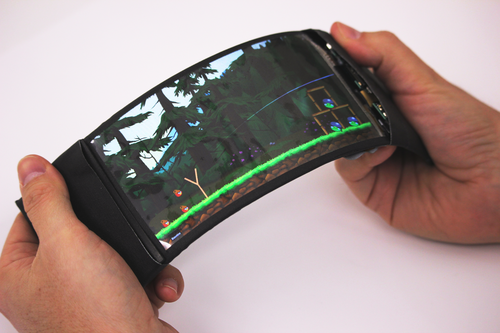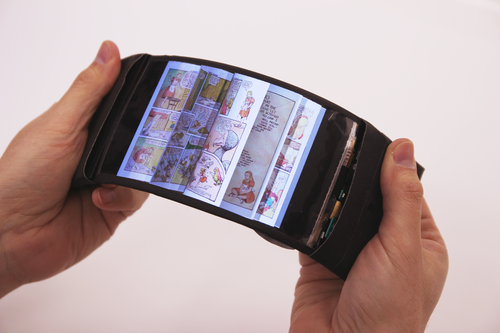Meet ReFlex – the world’s first flexible smartphone
A team from Queens University’s Human Media Lab has developed the world’s first flexible smartphone that actually lets you feel like you’re flipping through pages as you bend it. The simulation is the result of incorporated haptic bend input and allows users to experience physical tactile feedback while interacting with apps through bending gestures.

The full-color, high-resolution, wireless flexible smartphone has been coined ReFlex by the team and represents new type of physical interaction with our smartphones.
“When this smartphone is bent down on the right, pages flip through the fingers from right to left, just like they would in a book. More extreme bends speed up the page flips. Users can feel the sensation of the page moving through their fingertips via a detailed vibration of the phone. This allows eyes-free navigation, making it easier for users to keep track of where they are in a document,” said Roel Vertegaal director of the Human Media Lab at Queen’s University.
How it works
ReFlex is equipped with a high-definition 720p LG Display Flexible OLED touch screen powered by an Android 4.4 “KitKat” board mounted to the side of the display. Incorporate bend sensors located behind the display can detect the force with which a user bends the screen. That fore information is relayed to apps for use as input. ReFlex also features a voice coil that allows the phone to simulate forces and friction through detailed vibrations of the display. These vibrations, coupled with the passive force feedback felt when bending the display, allows for a realistic simulation of physical forces when interacting with virtual objects.
“This allows for the most accurate physical simulation of interacting with virtual data possible on a smartphone today,” said Dr. Vertegaal. “When a user plays the “Angry Birds” game with ReFlex, they bend the screen to stretch the sling shot. As the rubber band expands, users experience vibrations that simulate those of a real stretching rubber band. When released, the band snaps, sending a jolt through the phone and sending the bird flying across the screen.”
Don’t believe it? Take a look at the video below.
The technology was developed in anticaption of flexible smartphones predicted to hit the market within the next five years, according to Vertegaal. The Queen’s researchers will unveil the ReFlex prototype at the Conference on Tangible Embedded and Embodied Interaction (TEI) in the Netherlands.


Comments are closed, but trackbacks and pingbacks are open.